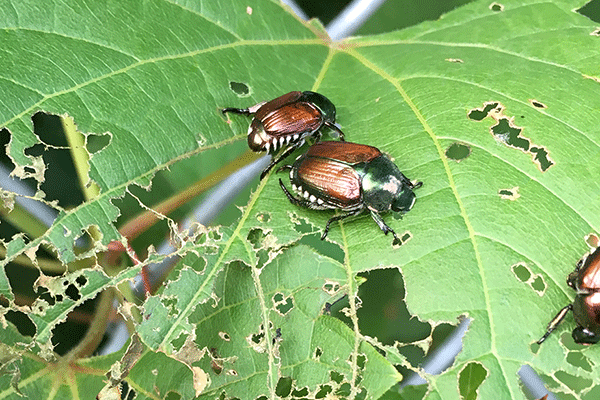| Serious Concerns | Major Symptom: |
|---|---|
| 1. Japanese beetle control | Strategies for professionals |
| 2. June 2nd growing degree days (GDD) | Several Nebraska sites below, Understanding Growing Degree Days |
| 3. Pest update | Pests to watch for based on Growing Degree Days (GDD) |
| 4. River birch dieback | Moderate to severe dieback in canopy |
| 5. Trees and drought | Thin canopies; branch and tree death |
| 6. Boxwood winter desiccation | Affected foliage and stems turn light tan; branches dead and brittle |
| 7. Ips bark beetles | Many BB-sized exit holes in bark; branch or tree death |
| Timely Topics | |
| 8. Brownheaded ash sawfly | Leaf damage ranging from pin-head sized holes to entire leaves skeletonized |
| 9. Curled leaves in tomatoes and peppers | Diagnostic tips for common problems |
| 10. White grub control | Make applications from mid to late June; preventive control more effective |
| 11. Broadleaf weed control | September-October best time for effective control |
| 12. Yellow nutsedge | June 1 - 21 prime time for control |
| Heads Up: For Your Information | |
| 13. Cool Season Lawn Calendar - Eastern Nebraska | New publication for use with clientele |
| 14. Commercial/Non-commercial pesticide applicator certification | Obtaining a new license or updating an expired license |
| 15. Digital Diagnostic Network - Need help with diagnostics? | Submit pictures and questions for diagnosis by Nebraska Extension experts. |
1. Japanese beetle controlStrategies for professionals
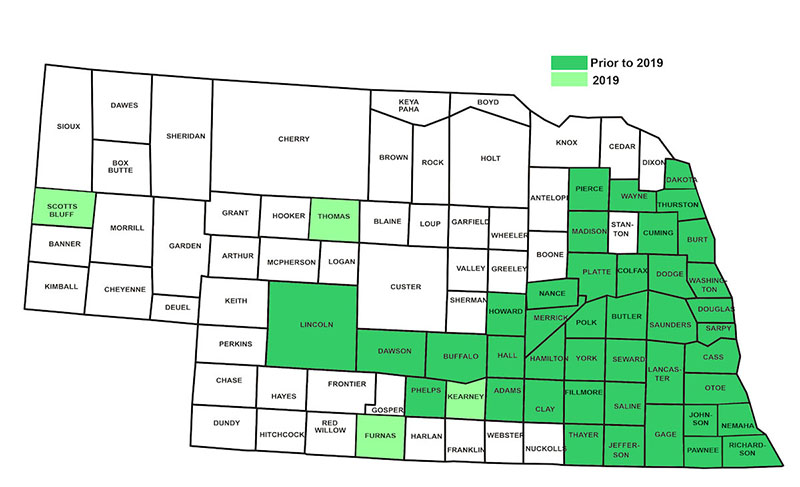 A new season of Japanese beetle control will begin this month. Growing degree day (GGD) models target adult emergence from 950 to 2150 GGD (base 50). Emergence timing varies across the state based on location and yearly weather variations, but an emergence estimate for several locations are below. Adult feeding damage will occur during this entire period and for several weeks afterward, as the last adults complete their lifecycle.
A new season of Japanese beetle control will begin this month. Growing degree day (GGD) models target adult emergence from 950 to 2150 GGD (base 50). Emergence timing varies across the state based on location and yearly weather variations, but an emergence estimate for several locations are below. Adult feeding damage will occur during this entire period and for several weeks afterward, as the last adults complete their lifecycle.
- Omaha – June 20 to August 3
- Lincoln - June 20 to August 1
- Grand Island - June 21 to August 6
- Norfolk - June 24 to August 11
- North Platte - June 27 to August 16
- Scottsbluff – June 30 to August 13
After emerging adults feed for a few days, begin mating and laying eggs. Larvae begin hatching in about two weeks and start feeding on turfgrass roots.
Strategies for Professionals
Adult beetle control – To protect pollinators, before applying insecticides on blooming plants, read and follow all label guidelines and restrictions on the products used. Examples of common restrictions include the following.
- Do not spray on windy days.
- Do not spray blooming, pollen-shedding or nectar-producing plants when bees are present.
- Spray late in the day or at dusk when bees have left the plants instead of during the day.
- Apply products to blooming plants after all flower petals have fallen.
- Do not apply products, by any application method, to linden, basswood or other Tilia species.
Conventional insecticides - Carbaryl, bifenthrin, cyfluthrin, permethrin and lambda-cyfluthrin provide about 2 weeks of control following a thorough application. Typically, two applications during peak adult flight periods, late June through early August, are needed for control. The first application should be made before plant damage becomes intolerable, but when adult beetles are abundant. Contact application.
Reduced risk insecticides – products classified by the Environmental Protection Agency as having minimal impact on human health and the environment. This includes Neem, Pyola (a blend of pyrethrin and canola oil) and Spinosad. These products will kill adult beetles, but only for about 3-7 days. Neem products can be effective repellants, reducing foliage damage when applied regularly (but no more than weekly). Contact application.
Systemic insecticides - Soil drench or injectable products are available to protect high value trees and other plants. Trees should be treated from mid-April through late May before beetles appear. Trees take in systemic products best during this time and the application is early enough for the insecticide to reach full strength within the tree before adult beetles emerge. Follow all label restrictions on product use, including all prohibitions for use on linden, basswood or other Tilia species.
Commonly used systemics include the following. (Not an all-inclusive list.)
- Acephate - Dendrex
- Imidacloprid – Imicide, IMA-jet, Pointer
- Dinotefuron – Dinocide, Safari, Transtect
White grub control – Larva begin hatching about two weeks after the first adult emergence dates. Turf products for the control of our common white grub also provide control of Japanese beetle grubs and should be applied from mid to late June.
Preventive control - The following products are effective against young grubs. Labels: c = commercial product, h = homeowner product.
- Chlorantraniliprole (anthranilic diamide) – Acelepryn(c), Scotts GrubEx (h)
- Clothianidin (neonicotinoid) – Arena (c)
- Halofenozide (synthetic insect growth regulator) - Mach 2 (c)
- Imidacloprid (neonicotinoid) – Merit (c), Bonide Grub Beater (h), BioAdvanced Complete Insect Killer (h)
- Thiamethoxam (neonicotinoid) – Meridian (c)
Chlorantraniliprole is an option for lawns where conservation of bees and pollinators is very important. If applied as a granule, it does not move into the flowers of any blooming weeds, such as dandelions or clover. If applied as a spray, once weed flowers present at the time of application are removed through mowing, the turf is safe for pollinators.
Halofenozide is another good option, considered very low or non-toxic to pollinators.
Rescue treatments - Trichlorfon (Dylox, BioAdvanced Grub Killer Plus) provides the best control due to its higher kill rate against mature white grubs. These products must be watered in for acceptable control. Moving the insecticide into the root zone involves applying ½ inch of water immediately after application. Do not use products that contain ONLY bifenthin, deltamethrin, cyfluthrin, permethrin, lambda-cyhalothrin or gamma-cyhalothrin for soil-applied grub control. These chemicals bind with organic matter at the soil surface and will not move down into the soil to provide effective grub control.
Thatch plays an important role in reducing the efficacy of turf insecticides applied for white grub control. If the thatch layer exceeds ½ inch, light aeration and increased post-treatment irrigation will enhance insecticide penetration and should improve white grub control. In problem areas, such as those with thick thatch layers, repeated irrigations may be necessary every three to four days to continue moving the insecticide into the soil. When white grubs are deeper in soil, curative treatments are more effective if a retreatment irrigation of 1/2 inch is applied 48 hours before the insecticide application. This will encourage grubs to move closer to the soil surface and enhance the level of white grub control.
Recommendations to Clientele and Homeowners
Control of white grubs in their lawns will not ensure zero beetle damage in their landscapes. Adult beetles are strong fliers and will move into any landscape from surrounding areas, particularly if favored food sources exist.
Manual control of adult beetles is a good strategy if only a few plants are affected. Beetles move quickly when disturbed so tapping, knocking or shaking them off the plant, rather than handpicking, may work best. Drop them into a container of soapy water.
Reduced risk pesticides - Formulations available to home gardeners for spray applications include the following. They provide 3-7 days residual control.
- Monterey 70% Neem Oil or Bonide Neem Oil
- Gardens Alive Pyola Vegetable, Fruit and Ornamental Insect Spray
- Bonide Captain Jack's Dead Bug Brew (spinosad)
Make sure homeowners understand the need to follow the label restrictions when using any pesticide on food crops and harvest timing after application.
Advise against the use of beetle traps. Research has shown traps attract many more insects than they catch, resulting in more harm than good for the landscape.
Damage in otherwise healthy, vigorous trees, even heavy damage, will not kill the tree. More on minimizing the impact of beetle damage in trees - Japanese Beetles in Nebraska, Nebraska Forest Service.
2. June 2nd growing degree day(GDD)
| Location | Accumulated Growing Degree Days |
|---|---|
| Grand Island, NE - Airport | 680 |
| Lincoln, NE - Airport | 741 |
| Omaha, NE - Airport | 724 |
| Norfolk, NE - Airport |
661 |
| North Platte, NE - Airport | 499 |
| Scottsbluff, NE - Airport | 458 |
3. Pest updatePests to watch for based on Growing Degree Days (GDD)
| GGD (base 50) | Insect | Lifestage present at this GGD |
|---|---|---|
| 325-350 | Lilac borer (peak adult emergence at 930, see below) | 1st adult emergence |
| 350-375 | Lesser peach tree borer | Adult flight |
| 350-500 | Oystershell scale | Peak adult emergence |
| 400-500 | Pine needle scale | 1st generation - hyaline stage (control target) |
| 400-500 | Emerald ash borer (peak adult emergence at 1000-2000, see below) | 1st adult emergence |
| 400-575 | Euonymous scale | 1st generation |
| 400-600 | Bronze birch borer | Adults, eggs, new larvae |
| 440-700 | Ash sawfly | 1st larvae appear |
| 575-710 | Greater peach tree borer | Adult emergence |
| 600-900 | Bagworm | Larvae appear |
| 850-900 | Mimosa webworm | 1st generation egg hatch |
| 850-900 | Fall webworm | Egg hatch |
| 930 | Lilac borer | 1st generation hyaline stage |
| 950-2150 | Japanese beetle | Adult emergence |
| 1000-2000 | Emerald ash borer | Peak adult emergence |
| 1200-1800 | Fall webworm |
Caterpillars feeding |
| 1250 | Codling moth | 2nd generation control stage |
| 1375 | American plum borer | 2nd generation |
| 1500 | Pine needle scale | 2nd generation control stage |
| 1700 | Zimmerman pine moth | adult flight |
| 1800-2200 | Banded ash clearwing | adult emergence |
| 1850-2025 | Fall webworm | Tents become apparent |
| 1925-1950 | Magnolia scale | Egg hatch |
For a more complete list, visit Michigan State University GGD of Landscape Insects or GGD of Conifer Insects.
4. River birch diebackModerate to severe dieback in canopy
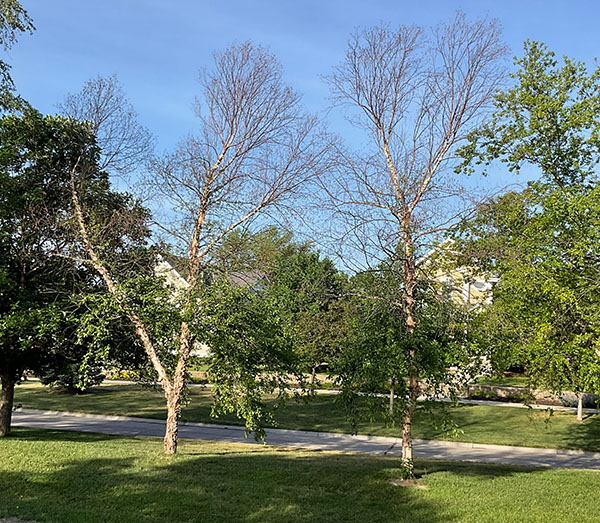 We are seeing river birch with up to or over half of their top branches dead. In most cases, the cause of dieback this year is drought stress. River birch prefers moist soil, including semi-aquatic conditions along rivers, making them susceptible to the severe to exceptional drought we are currently in.
We are seeing river birch with up to or over half of their top branches dead. In most cases, the cause of dieback this year is drought stress. River birch prefers moist soil, including semi-aquatic conditions along rivers, making them susceptible to the severe to exceptional drought we are currently in.
Watering - People may assume lawn irrigation is enough for established trees. In average rainfall years, it might be; however, we are far behind average precipitation and trees are drought stressed. Trees should be watered deeply, 8” to 12”, using soaker hoses. Water from about six inches away from the trunk to well beyond the drip line. Before watering, professionals should encourage homeowners to check the soil with a screw driver to assess soil moisture levels and avoid overwatering.
Aids to recovery - Place bark or wood chip mulches over roots (2” to 4” deep in a six-foot diameter ring and not against the trunk) to keep tree root cooler and moist. Birch trees are somewhat forgiving and pruning out the dead might allow young trees to recover. A pliable side branch may need to be trained to become a new central leader. Use correct watering and mulching, but fertilizing stressed trees is best avoided.
5. Trees and droughtThin canopies; branch and tree death
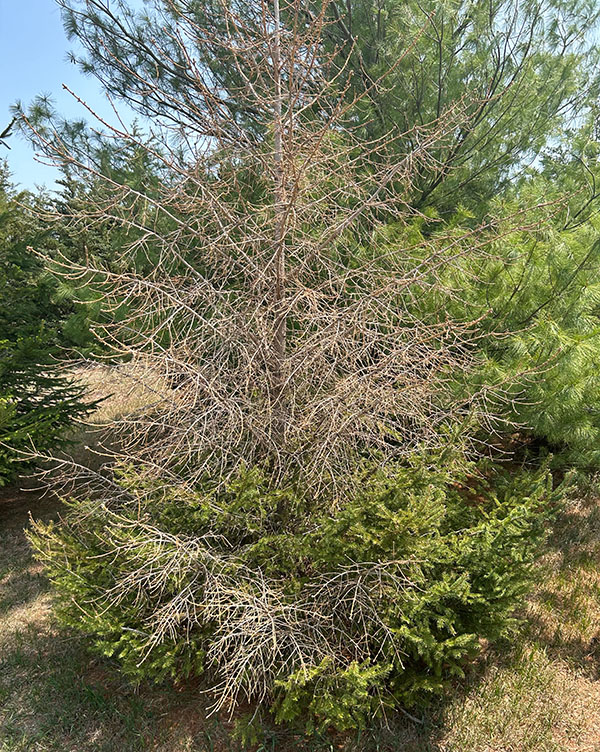 We are familiar with winter dessication injury on evergreen conifers, especially with many Arborvitae, but this year spruce and Japanese yews are turning brown, too. Other types of shade and ornamental trees may also be impacted by drought, similar to River Birch mentioned above.
We are familiar with winter dessication injury on evergreen conifers, especially with many Arborvitae, but this year spruce and Japanese yews are turning brown, too. Other types of shade and ornamental trees may also be impacted by drought, similar to River Birch mentioned above.
Homeowners may ask why one tree is affected and not another. There is usually an underlying cause. Younger trees with less established root systems, trees planted too deep, those with girdling roots or mower or weed trimmer injury on the trunk, and trees that have not received correct supplemental watering the last two years may have dieback or dead branches. Teach clients correct tree planting and tree care practices and encourage them to water in the absence of rainfall. Depending on soil type, established trees may only need a deep watering once a month. Newly planted and younger trees will need more frequent irrigation.
6. Boxwood winter desiccationAffected foliage and stems turn light tan; dead and brittle
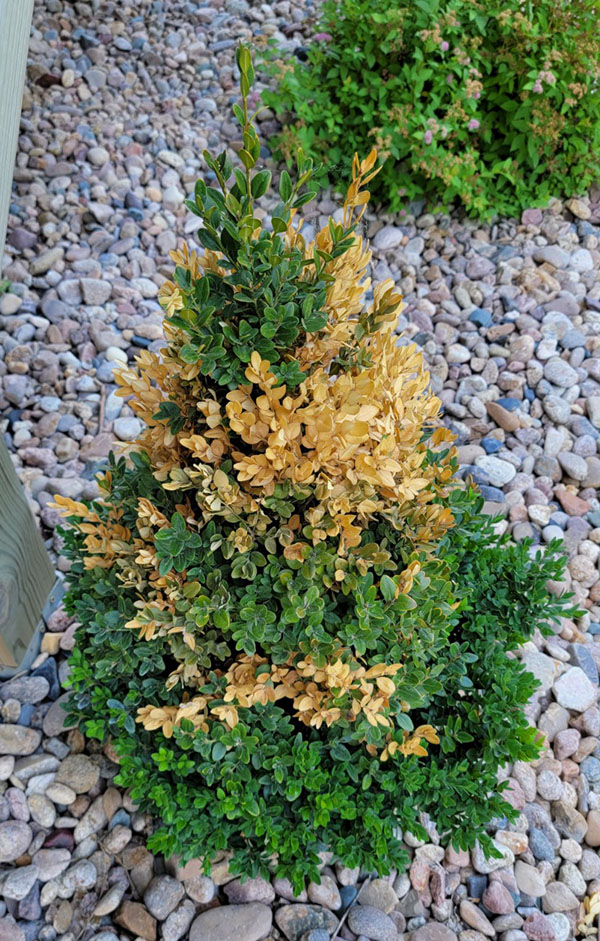 Boxwood browning is a common site and is usually caused by winter dessication. The problem is planting the wrong plant in the location and drought stress. Boxwood planted in full sun locations and/or exposed to wind, and certain cultivars, are showing the most damage. Some cultivars, like Green Mountain and Green Velvet, planted in the right location and not pruned after July are not showing as much damage. Site boxwood in the right location. Remind homeowners of the importance of correct summer and fall watering, to avoid pruning after July, and the possible need for winter screening with burlap/snow fence and the application of antitranspirants two to three times during winter.
Boxwood browning is a common site and is usually caused by winter dessication. The problem is planting the wrong plant in the location and drought stress. Boxwood planted in full sun locations and/or exposed to wind, and certain cultivars, are showing the most damage. Some cultivars, like Green Mountain and Green Velvet, planted in the right location and not pruned after July are not showing as much damage. Site boxwood in the right location. Remind homeowners of the importance of correct summer and fall watering, to avoid pruning after July, and the possible need for winter screening with burlap/snow fence and the application of antitranspirants two to three times during winter.
Boxwood Blight, to date, has only been found in nursery stock in Nebraska. It is good to be aware of this disease and know what to watch for. See the link below from Purdue University. If suspect boxwood are seen, take a sample to your local Extension office or send it into the UNL Plant and Pest Diagnostic Clinic.
Boxwood Blight, Purdue University
7. Ips bark beetleMany BB-sized exit holes in bark; branch or tree death
Bark beetle damage on pines is increasing in western Nebraska mainly due to drought stress. Ips beetles begin emerging in early spring. Adults tunnel into branches or trunks, producing sawdust. Tunnels are constructed beneath the bark in a Y, X or H pattern. Larvae hatch from eggs laid along the tunnels and excavate smaller tunnels leading from the main tunnel. Two or more generations occur per year. The key to preventing bark beetle damage is to maintain tree health with correct planting, watering and mulching. High value trees can be treated with insecticides applied to the trunk and branches in spring.
Bark Beetles of Pine, Nebraska Forest Service
8. Brownheaded ash sawflyLeaf damage ranging from pin-head sized holes to entire leaves skeletonized
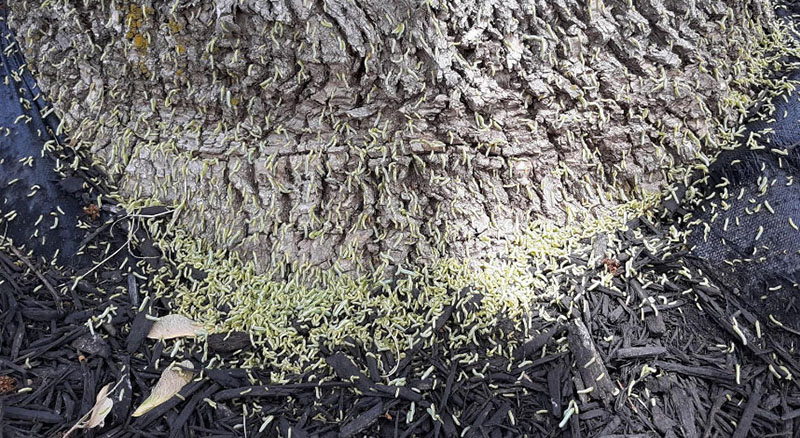 The larve of ash sawfly are tiny green worms which feed on the folige of ash trees and have appeared in large numbers this year, especially in the Omaha and Lincoln areas. Adults are a dark-colored, gnat-sized stingless wasp. When the caterpillars are mature, they drop to the ground and burrow into the soil beneath the tree. They enter the soil, develop a pupal case and remain in the soil until next spring. There is only one generation per year.
The larve of ash sawfly are tiny green worms which feed on the folige of ash trees and have appeared in large numbers this year, especially in the Omaha and Lincoln areas. Adults are a dark-colored, gnat-sized stingless wasp. When the caterpillars are mature, they drop to the ground and burrow into the soil beneath the tree. They enter the soil, develop a pupal case and remain in the soil until next spring. There is only one generation per year.
While young larvae feed on ash leaves creating pin-head sized holes. Mature larvae often eat away all the tisue between leaf veins, resulting in skeletonization. However, even high levels of leaf damage are rarely harmful to healthy, vigorous ash trees. The tree continues to have plenty of leaves and green tissue to do the job of photosynthesis. And keep in mind tears or holes in tree leaves may just be the result of windy weather tattering young leaves, not insect damage.
Management is rarely needed. They can easily be knocked off trees with water, or rain if we would get any. May is also National Bird Month so simply ignoring the worms, and not applying an insecticide to control them, will provide tasty meals for birds.
Ash Sawfly, Nebraska Extension
9. Curled leaves in tomatoes and peppersDiagnostic tips for common problems
Curled or distored leaves can have several causes, including weather extremes, a virus disease, or herbicide drift. It is important to distinguish which is the cause. With herbicide injury and virus diseases, plants are best removed and destroyed.
- With weather extremes, leaves may be curled or rolled but otherwise appear fairly normal. On hot, windy days, leaves curl to reduce transpiration of water from their leaves.
- With herbicide drift, other plants in the garden or nearby are likely to show signs of leaf curling/distortion as well. Typically plants will be stunted and not grow for a couple weeks after the drift occurs, but eventually they will start to grow again and the new growth will look normal.
- With a virus disease, leaves are curled, distorted and may be off-color. Often, the leaf curling and distortion is not as dramatic as that seen following herbicide drift. New growth will continue to be affected. Some viral diseases include curly top, tomato mosaic virus, and tomato yellow leaf virus.
10. White grub controlMake applications from mid to late June; preventive control more effective
Control depends on proper timing of insecticide applications and moving the insecticide into the root zone where grubs feed. Preventive control applications are made from mid to late June. Curative or rescue treatments are made in August or September.
Preventive - The following products are effective against young grubs. Labels: c = commercial product, h = homeowner product.
- Chlorantraniliprole – Acelepryn(c), Scotts GrubEx (h)
- Clothianidin – Arena (c)
- Halofenozide - Mach 2 (c)
- Imidacloprid – Merit (c), Bonide Grub Beater (h), BioAdvanced Season Long Grub Control + fertilizer (h)
- Thiamethoxam – Meridian (c)
Curative (rescue treatments) - Trichlorfon (Dylox, BioAdvanced Grub and Insect Control) provides the best control due to its higher kill rate against mature white grubs. These products must be watered in for acceptable control. Moving the insecticide into the root zone involves applying ½ inch of water immediately after application. Do not use products that contain ONLY bifenthin, deltamethrin, cyfluthrin, permethrin, lambda-cyhalothrin or gamma-cyhalothrin for soil-applied grub control. These chemicals bind with organic matter at the soil surface and will not move down into the soil to provide effective grub control.
Thatch plays an important role in reducing the efficacy of turf insecticides applied for white grub control. If the thatch layer exceeds ½ inch, light aeration and increased post-treatment irrigation will enhance insecticide penetration and should improve white grub control. In problem areas, such as those with thick thatch layers, repeated irrigations may be necessary every three to four days to continue moving the insecticide into the soil. When white grubs are deeper in soil, curative treatments are more effective if a retreatment irrigation of 1/2 inch is applied 48 hours before the insecticide application. This will encourage grubs to move closer to the soil surface and enhance the level of white grub control.
11. Broadleaf weed controlSeptember-October best time for effective control
Why wait until fall to kill weeds? Here are a few good reasons.
- Broadleaf weed control is not as effective during summer and there is increased risk of injury to non-target plants.
- Larger, more mature weeds are also more difficult to control.
- Herbicide control is less effective and turf safety decreases when weeds are treated under low soil moisture (drought).
- Air temperatures higher than 85F increase the chance of turf injury as well as herbicide volatization which leads to drifting onto nontargets.
- Perennial broadleaf weeds often regrow from roots with summer watering and fertilization.
September and October are the best months to control perennial broadleaf weeds with herbicides. If weed control is needed during summer, spot treat individual weeds when environmental conditions are cooler and not windy.
12. Yellow nutsedge controlJune 1 - 21 prime time for control
This perennial sedge typically emerges from underground tubers in late May in Nebraska. The best time for herbicide control applications are from the first week of June to June 21 - before plants develop new tubers. To reduce nutsedge, mow tall and avoid overwatering. Hand-pulling is effective where there are fewer plants. When herbicides are used, sulfentrazone (Dismiss), imazosulfuron (Celero), halosulfuron (SedgeHammer), and mesotrione (Tenacity) are labeled for postemergence control in cool-season turfgrasses and buffalograss.
Yellow Nutsedge Control (homeowners), Purdue Extension
Yellow Nutsedge (professionals), PennState Extension
14. Commercial/Non-commercial pesticide applicatorsObtaining a new license or updating an expired license
If you have a pesticide applicators license which expired in April 2023 or you need to get a new license, testing options are listed below.
Testing-only Options
- Closed-book exams are given by the Nebraska Department of Agriculture (NDA). Preregistration is not required an there is no cost. Visit the link below for a list of available test-only dates, times and locations - https://pested.unl.edu/.
- NDA computer-based testing is provided through the Pearson-Vue company. Click here for a list of testing sites, categories available, dates, and registration information. Cost $55 per exam. (For applicators with multiple categories on their license, each category is charged the full testing fee.)
Commercial/noncommercial applicators are professionals who apply restricted-use pesticides for hire or compensation. Anyone who applies pesticides to the property of another person, either restricted- or general-use products, for control of pests in lawns, landscapes, buildings or homes must also have a commercial pesticide applicators license. Public employees (those employed by a town, county, state) applying mosquito control pesticides whether restricted- or general-use, must also hold a commercial or noncommercial certification.
15. Digital Diagnostic Network - Need help with diagnostics?Submit pictures and questions for diagnosis by Nebraska Extension experts
Do you or your clients have questions you need help answering? Maybe you are a lawn care person and they're asking about trees, shrubs, or flowers? While you can refer them to their local Extension office, another option is Digital Diagnostic Network. Homeowners, lawn care professionals, pest control operators and others are invited to submit questions and photos through this website or with the assistance from an Extension professional at any Nebraska Extension office. All offices are equipped with high-resolution digital image capturing technology. Whether the question is about a lawn weed, insects on a plant, diseases in a shrub border or other, an expert panel of Extension professionals will review and respond to the question. To get started, create an account so the question can be reviewed and responded to via email. For more information and to create an account, go to Digital Diagnostic Network.
Bugging Out With Your Camera Phone - Tips on how to get a good picture.
Reference to commercial products or trade names is made with the understanding that no discrimination is intended and no endorsement by Nebraska Extension is implied. Use of commercial and trade names does not imply approval or constitute endorsement by Nebraska Extension. Nor does it imply discrimination against other similar products.
